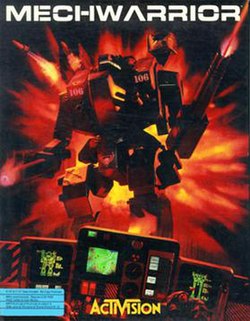MechWarrior (1989 video game)
| MechWarrior | |
|---|---|
 |
|
| Developer(s) | Dynamix |
| Publisher(s) | Activision |
| Producer(s) | Steven Ackrich John A. S. Skeel |
| Designer(s) | Paul Bowman Terry Ishida John A. S. Skeel Damon Slye |
| Programmer(s) | Paul Bowman Peter Fokos |
| Writer(s) | Paul Bowman Mark Brenneman |
| Composer(s) | Michael Latham Russell Lieblich Bryce Morcello |
| Platform(s) | MS-DOS, Sharp X68000 |
| Release | 1989 |
| Genre(s) | Vehicular combat game |
| Mode(s) | Single player |
MechWarrior is the first video game released in the BattleTech game series. MechWarrior was the first video game to offer the player a chance to pilot a BattleMech from the view of a pilot (a MechWarrior). With this game the player has a great deal of freedom when compared to many of the follow-up MechWarrior games, which include choosing missions, buying & selling 'Mechs and parts, hiring lance-mates, and traveling throughout the Inner Sphere. Underneath the major game mechanics, the player had the option of following a role playing style story arc that would unfold over a five-year (game time) period.
The game was ported to the Japanese Sharp X68000 home computer in 1992 under the name Battletech.
The story follows a mechwarrior by the name of Gideon Braver Vandenburg. His family has been murdered and the chalice that proves he is heir to the throne of his planet, Ander's Moon, has been stolen. Without the chalice he is exiled. Gideon must develop a force of mechwarriors and battlemechs, find those who committed the acts against his family, and take his revenge within five years or all is lost.
The story ends with the defeat of the Dark Wing Mercenaries.
Mechwarrior revolves around three basic elements of play. The player can travel around an accurate map of the Inner Sphere negotiating contracts with the five Great Houses. Depending on the players actions, his mercenary unit will develop a reputation with each house which can bring about larger and more lucrative missions. A negative reputation can also be created if the player fights against a house in several missions. In this situation players will find that house is no longer willing to negotiate a contract.
The second element revolves around the battlemechs within the game. Battlemechs can be bought and sold or repaired from combat damage. In this way, the player can act as a merchant and acquire mechs on one planet and sell them on another planet to gain profit. Mechwarriors, too can be hired at the local bar with ranging levels of skill. As above, the unit's reputation will determine the quality of potential recruits.
Finally, there is the combat simulation. Depending on the contract for a mission, the player must meet certain criteria ranging from defense of a facility to outright destruction of the enemy. Combat is shown in first person from the cockpit of a battlemech. The game's engine uses simple vector based graphics for the actual combat.
The three elements combined to create a unique game that was part RPG, part economic, and part simulation.
1989's Mechwarrior was the first BattleTech simulator that placed the user within an actual battlemech to pilot in first person. While the flat-shaded 3D graphics were very simple, individual mechs were easy to identify. The player begins with a damaged Jenner and has the opportunity to build over time a full lance of 4 battlemechs with the ability to choose from a total of 8 designs. Each mech was well balanced and had its own unique role within the game. The Locust and Jenner were specially designed for quick strike style missions while the heaviest machines such as the Battlemaster and Marauder could walk through heavy fire and survive. Medium mechs such as the Phoenix Hawk and Shadow Hawk had the ability to leap over terrain with jump jets and harass enemies from behind (the Jenner also has this property). Finally the heavy class including both the Rifleman and Warhammer could bring the most firepower to bear. Every class had its own special role and was instrumental to the gameplay.
...
Wikipedia
